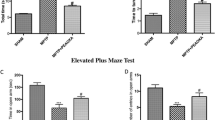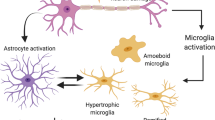Abstract
We investigated the therapeutic effect of zonisamide against 1-methyl-4-phenyl-1,2,3,6-tetrahydropyridine (MPTP) neurotoxicity in mice, using Western blot analysis, immunohistochemistry and behavioral test. Our Western blot analysis and immunohistochemical study showed that the post-treatment with zonisamide prevented significantly dopaminergic cell damage, the depletion of tyrosine-hydroxylase (TH) protein levels and the proliferation of microglia in the striatum and/or substantia nigra 8 days after MPTP treatment. Furthermore, our behavioral study showed that the post-treatment with zonisamide attenuated significantly the motor deficits 7 days after MPTP treatment. These results show that zonisamide has the therapeutic effect in the MPTP model of Parkinson’s disease (PD) in mice. Our study also demonstrates the neuroprotective effect of zonisamide against dopaminergic cell damage after MPTP treatment in mice. Thus our present findings suggest that therapeutic strategies targeted to the activation of TH protein and/or the inhibition of microglial activation with zonisamide may offer a great potential for restoring the functional capacity of the surviving dopaminergic neurons in individuals affected with PD.








Similar content being viewed by others
References
Ahlskog JE, Munenter MD (2001) Frequency of levodopa-related dyskinesias and motor fluctuations as estimated from the cumulative literature. Mov Disord 16:448–458
Aoki E, Yano R, Yokoyama H, Kato H, Araki T (2009) Role of nuclear transcription factor kappa B (NF-kappaB) for MPTP (1-methyl-4-phenyl-1, 2, 3, 6-tetrahyropyridine)-induced apoptosis in nigral neurons of mice. Exp Mol Pathol 86:57–64
Asanuma M, Miyazaki I, Diaz-Corrales FJ, Miyoshi K, Ogawa N, Murata M (2008) Preventing effects of a novel anti-parkinsonian agent zonisamide on dopamine quinone formation. Neurosci Res 60:106–113
Beal MF (2003) Mitochondria, oxidative damage, and inflammation in Parkinson’s disease. Ann N Y Acad Sci 991:120–131
Block ML, Hong JS (2005) Microglia and inflammation-mediated neurodegeneration: multiple triggers with a common mechanism. Prog Neurobiol 76:77–98
Bové J, Prou D, Perier C, Przedborski S (2005) Toxin-induced models of Parkinson’s disease. NeuroRx 2:484–494
Członkowska A, Kohutnicka M, Kurkowska-Jastrzebska I, Członkowski A (1996) Microglial reaction in MPTP (1-methyl-4-phenyl-1, 2, 3, 6-tetrahydropyridine) induced Parkinson’s disease mice model. Neurodegeneration 5:137–143
Dauer W, Przedborski S (2003) Parkinson’s disease: mechanisms and models. Neuron 39:889–909
Dringen R, Gutterer JM, Hirrlinger J (2000) Glutathione metabolism in brain metabolic interaction between astrocytes and neurons in the defense against reactive oxygen species. Eur J Biochem 267:4912–4916
Gallo F, Morale MC, Spina-Purrello V, Tirolo C, Testa N, Farinella Z, Avola R, Beaudet A, Marchetti B (2000) Basic fibroblast growth factor (bFGF) acts on both neurons and glia to mediate the neurotrophic effects of astrocytes on LHRH neurons in culture. Synapse 36:233–253
Gluck MR, Youngster SK, Ramsay RR, Singer TP, Nicklas WJ (1994) Studies on the characterization of the inhibitory mechanism of 4'-alkylated 1-methyl-4-phenylpyridinium and phenylpyridine analogues in mitochondria and electron transport particles. J Neurochem 63:655–661
Hasegawa E, Takeshige K, Oishi T, Murai Y, Minakami S (1990) 1-Methyl-4-phenylpyridinium (MPP+) induces NADH-dependent superoxide formation and enhances NADH-dependent lipid peroxidation in bovine heart submitochondrial particles. Biochem Biophys Res Commun 170:1049–1055
Hayakawa T, Higuchi Y, Nigami H, Hattori H (1994) Zonisamide reduces hypoxic-ischemic brain damage in neonatal rats irrespective of its anticonvulsive effect. Eur J Pharmacol 257:131–136
Heikkila RE, Manzino L, Cabbat ES, Duvosion RC (1984) Protection against the dopaminergic neurotoxicity of 1-methyl-4-phenyl-1, 2, 3, 6-tetrahydroxypyridine by monoamine oxidase inhibitors. Nature 311:467–469
Ito T, Yamaguchi T, Miyazaki H, Sekine Y, Shimizu M, Ishida S, Yagi K, Kakegawa N, Seino M, Wada T (1982) Pharmacokinetic studies of AD-810, a new antiepileptic compound. Phase I trials. Arzneimittelforschung 32:1581–1586
Jakowec MW, Nixon K, Hogg E, McNeill T, Petzinger GM (2004) Tyrosine hydroxylase and dopamine transporter expression following 1-methyl-4-phenyl-1, 2, 3, 6-tetrahydropyridine-induced neurodegeneration of the mouse nigrostriatal pathway. J Neurosci Res 76:539–550
Kurkowska-Jastrzebska I, Wrońska A, Kohutnicka M, Członkowski A, Członkowska A (1999) The inflammatory reaction following 1-methyl-4-phenyl-1, 2, 3, 6-tetrahydropyridine intoxication in mouse. Exp Neurol 156:50–61
McElroy SL, Suppes T, Keck PE Jr, Black D, Frye MA, Altshuler LL, Nolen WA, Kupka RW, Leverich GS, Walden J, Grunze H, Post RM (2005) Open-label adjunctive zonisamide in the treatment of bipolar disorders: a prospective trial. J Clin Psychiatry 66:617–624
McGeer PL, Itagaki S, Boyes BE, McGeer EG (1998) Reactive microglia are positive for HLA-DR in the substantia nigra of Parkinson's and Alzheimer's disease brains. Neurology 38:1285–1291
Morale MC, Serra PA, L'episcopo F, Tirolo C, Caniglia S, Testa N, Gennuso F, Giaquinta G, Rocchitta G, Desole MS, Miele E, Estrogen MB (2006) Estrogen, neuroinflammation and neuroprotection in Parkinson's disease: glia dictates resistance versus vulnerability to neurodegeneration. Neuroscience 138:869–878
Murata M (2004) Novel therapeutic effects of the anti-convulsant, zonisamide, on Parkinson’s disease. Curr Pharm Des 10:687–693
Murata M, Hasegawa K, Kanazawa I (2007) Zonisamide improves motor function in Parkinson’s disease: a randomized, double-blind study. Neurology 68:45–50
Nawashiro H, Brenner M, Fukui S, Shima K, Hallenbeck JM (2000) High susceptibility to cerebral ischemia in GFAP-null mice. J Cereb Blood Flow Metab 20:1040–1044
Ogawa N, Asanuma M, Miyazaki I, Diaz-Corrales F, Miyoshi K (2005) L-DOPA treatment from the viewpoint of neuroprotection: possible mechanism of specific and progressive dopaminergic neuronal death in Parkinson’s disease. J Neurol 252(suppl 4):iv23–iv31
Ookubo M, Yokoyama H, Kato H, Araki T (2009) Gender differences of MPTP (1-methyl-4-phenyl-1,2,3,6-tetrahydropyridine) neurotoxicity in C57BL/6 mice. Mol Cell Endocrinol 311:62–68
Rock D, MacDonald R, Taylor C (1989) Blockade of sustained repetitive action potentials in cultured spinal cord neurons by zonisaimde (AD 810, CI 912), a novel anticonvulsant. Epilepsy Res 3:138–143
Schauf C (1987) Zonisamide enhances slow sodium inactivation in Myxicola. Brain Res 413:185–188
Sriram K, Pai KS, Boyd MR, Ravindranath V (1997) Evidence for generation of oxidative stress in brain by MPTP: in vitro and in vivo studies in mice. Brain Res 749:44–52
Sugama S, Yang L, Cho BP, DeGiorgio LA, Lorenzl S, Albers DS, Beal MF, Volpe BT, Joh TH (2003) Age-related microglial activation in 1-methyl-4-phenyl-1, 2, 3, 6-tetrahydropyridine (MPTP)-induced dopaminergic neurodegeneration in C57BL/6 mice. Brain Res 964:288–294
Suzuki S, Kawakami K, Nishimura S, Watanabe Y, Yagi K, Seino M, Miyamoto K (1992) Zonisamide blocks T-type calcium channel in cultured neurons of rat cerebral cortex. Epilepsy Res 12:21–27
Tanaka A, Watanabe Y, Kato H, Araki T (2007) Immunohistochemical changes to related ageing in the mouse hippocampus and subventicular zone. Mech Ageing Dev 128:303–310
Tipton KF, Singer TP (1993) Advances in our understanding of the mechanisms of the neurotoxicity of MPTP and related compounds. J Neurochem 61:1191–1206
Wu DC, Jackson-Lewis V, Vila M, Tieu K, Teismann P, Vadseth C, Choi DK, Ischiropoulos H, Przedborski S (2002) Blockade of microglial activation is neuroprotective in the 1-methyl-4-phenyl-1, 2, 3, 6-tetrahydropyridine mouse model of Parkinson disease. J Neurosci 22:1763–1771
Yabe H, Choudhury ME, Kubo M, Nishikawa N, Nagai M, Nomoto M (2009) Zonisamide Increases Dopamine Turnover in the Striatum of Mice and Common Marmosets Treated With MPTP. J Pharmacol Sci 110:64–68
Yano R, Yokoyama H, Kuroiwa H, Kato H, Araki T (2009) A novel anti-parkinsonian agent, zonisamide, attenuates MPTP-induced neurotoxicity in mice. J Mol Neurosci 39:211–219
Yokoyama H, Takagi S, Watanabe Y, Kato H, Araki T (2008) Role of reactive nitrogen and reactive oxygen species against MPTP neurotoxicity in mice. J Neural Transm 115:831–842
Zigmond MJ, Stricker EM (1989) Animals models of parkinsonism using selective neurotoxins: clinical and basic implications. Int Rev Neurobiol 31:1–79
Acknowledgements
This study was supported in part by Grant-in-Aid for Scientific Research (136700627 and 13671095) from the Ministry of Science and Education in Japan.
Author information
Authors and Affiliations
Corresponding author
Rights and permissions
About this article
Cite this article
Yokoyama, H., Yano, R., Kuroiwa, H. et al. Therapeutic effect of a novel anti-parkinsonian agent zonisamide against MPTP (1-methyl-4-phenyl-1,2,3,6-tetrahydropyridine)neurotoxicity in mice. Metab Brain Dis 25, 135–143 (2010). https://doi.org/10.1007/s11011-010-9191-0
Received:
Accepted:
Published:
Issue Date:
DOI: https://doi.org/10.1007/s11011-010-9191-0




